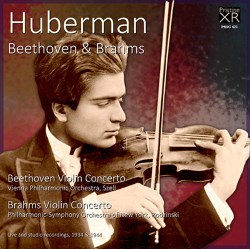
|
Ludwig van BEETHOVEN (1770-1827)
Violin Concerto in D Major, Op 61 [39:10]
Johannes BRAHMS (1833-1897)
Violin Concerto in D, Op.77 [36:03]*
Bronislaw Huberman (violin)
Vienna Philharmonic Orchestra/George Szell
Philharmonic-Symphony Orchestra of New York/Artur Rodzinski*
rec. 18-20 June, 1934, venue not given (Beethoven); 23 January 1944, live, Carnegie Hall, New York (Brahms)
PRISTINE AUDIO PASC421 [76:23]
Huberman was always a violinist to polarize
opinion, due to his individuality and very personal approach. I tend
now to side with his advocates rather than his detractors. It wasn’t always so; having listened more to his playing of late, time has brought me to a greater appreciation of his qualities as a musician. Amongst those who saw beyond the anachronistic style and focused on those more elevated musical qualities was the influential music critic Hans Keller, who was asked by Carl Flesch’s son to provide an appendix to his father’s Memoirs (Rockcliff, 1957). This helped to give a more balanced assessment after the rather negative analysis of Huberman’s technique by the distinguished pedagogue. Flesch’s son justifies the inclusion of the appendix by saying ‘the fact that there can be opinions on Huberman which are so diametrically opposed shows that his was a strong personality of many facets’.
Born in Poland in 1882, Huberman started playing the violin at the age of six. When he was ten he met Joachim, who recognized the child’s gifts. After lessons both with Markees, Joachim’s assistant, and later with Marsick in Paris, he took to the road. Early on in his career he was given a Strad ’The Gibson’, which was twice stolen whilst in his possession. The violin has subsequently been in the hands of Ruggiero Ricci and Norbert Brainin. It is currently with Joshua Bell. In 1936 Huberman founded the Palestine Symphony Orchestra - later to become the Israel Philharmonic in 1948 - for Jewish musicians who would have had an uncertain fate at the hands of the Nazis, had they stayed put. Toscanini conducted the orchestra’s first performance. Huberman died in 1947.
The violinist didn’t venture into the studio that often, so what we have is of great value. Yet, despite the slender discography, the Beethoven concerto with Szell and the VPO has had plenty of mileage as far as reissues are concerned. In the opinion of many it has become a classic. I have the David Lennick transfer on Naxos, and the Keith Hardwick on EMI, both of which I used for comparison. Brian Crimp’s efforts on APR are well-regarded, but unfortunately I’ve never heard them. Preiser and the Japanese Label Opus Kura have also been in on the act.
Surprisingly, this is Szell’s only commercial recording of the Beethoven Concerto. He responds well to the violinist’s highly individualistic and even maverick approach. There is much flexibility in his conducting. The Vienna Philharmonic play to the manner born. Huberman’s is a fairly brisk reading, and technically he is on top form throughout. Everything seems to have come together at those sessions in 1934, and the violinist reaches heights I have never before heard him achieve. Inspirational, sublime and Olympian are words that spring to mind. In the cadenza, he shuns the more often played Joachim and Kreisler cadenzas. Instead he opts for one, unknown to me, but probably penned by himself. Whilst not quite as inspired as the two aforementioned, it nevertheless showcases his formidable virtuosity.
As far as transfers are concerned, I have never been fond of David Lennick’s for Naxos. Whilst the top is satisfactory, the bottom appears somewhat congested and lacking focus. I have always enjoyed Keith Hardwick’s EMI transfer, where there is more of a balance struck between orchestra and soloist, and more clarity and detail discerned. Andrew Rose, for Pristine, goes one step further and, to my mind, this is the one to go for. Here there is more depth and warmth, and this magnificent recording can be heard in all its glory.
The Brahms Concerto is a live broadcast recording from Carnegie Hall, New York on the 23 January 1944. It appeared several years ago on a Music and Arts CD. In 1896 the young violinist, aged only thirteen, gave a performance of this work. Seated in the audience was the composer himself, whose enthusiasm and gratitude resulted in the presentation of an autographed photo to the gifted boy.
If I thought things couldn’t get any better after the Beethoven, the Brahms is sensational. This live traversal from 1944 is a highly compelling and persuasive account in more than acceptable sound quality for its age and provenance. Huberman summons up all of his powers to deliver an inspirational account of stature and distinction. The first movement is passionate and intense with an eye on the over-arching architecture of this symphonic structure. He again uses an unfamiliar cadenza, maybe his own, but more idiomatic than the one played in the Beethoven. The second movement is eloquent and exquisitely phrased. Intonation is pure. He employs the occasional dated portamento here and there, odd-sounding to those of us whose ears have been honed in the post-Heifetz era, but so what. The finale is energetic, rhythmically propulsive and delivered with verve and panache. What adds to the success of the mix is Artur Rodzinski’s sensitive support and the New York Philharmonic’s refined playing. I would single out for special mention the ethereal oboe solo at the start of the slow movement. The audience shows its enthusiasm and appreciation with applause at the end of each movement.
This release should be enthusiastically taken up, not only by Huberman fans, but also by those appreciative of fine violin playing. No booklet is provided, but full programme notes are available online.
Stephen Greenbank
 |
 |
|
